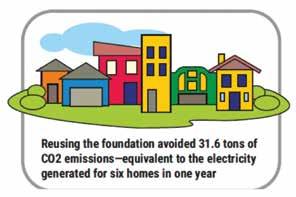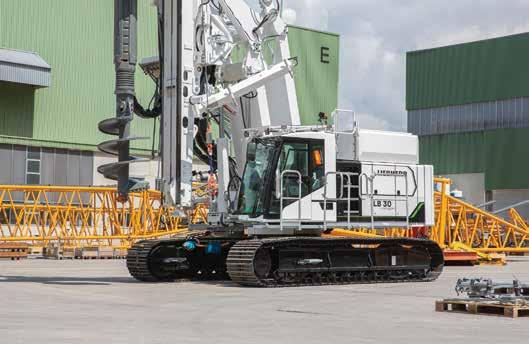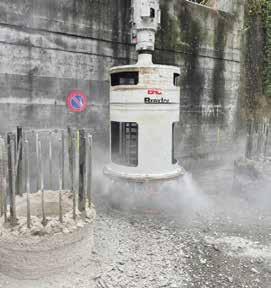
4 minute read
Construction nearly complete on Travers solar project
NEW TECHNOLOGY
Construction nearly complete on Travers solar project
Production pile install.
This impressive project is expected to offset more than 470,000 tonnes of greenhouse gas emissions annually
By Lisa Kopochinski
When completed later this year, the Travers solar project—a 465MW photovoltaic power plant in Vulcan County, Alberta, will be the biggest solar power plant in Canada.
Expected to generate power to meet the electricity needs of more than 150,000 homes, it will also offset more than 500,000 tonnes of greenhouse gas emissions annually. Located on approximately 3,330 acres of privatelyowned, cultivated, and grazing land approximately eight kilometres southwest of the Village of Lomond, the area features significant solar resources.
Greengate Power Corporation is a Calgary-based renewable energy company that developed this project. In April 2019, Greengate Power applied to the Alberta Electric System Operator (AESO) to connect the Travers solar plant to the Alberta Interconnected Electric System (AIES). Operated by AESO, the AIES transmission and distribution system is the main grid in the region and provides approximately 85 per cent of electricity in the province. (Source: NS Energy magazine)
Financier Copenhagen Infrastructure Partners (CIP) hired PCL Construction Management as the general contractor on this impressive $700 million project that is expected to create more than 200 full-time jobs during the construction phase, and up to 10 permanent positions during the operation phase.
LARGEST HELICAL PILING PROJECT IN CANADA
Roterra Piling Ltd., a piling solution provider with locations in Edmonton and Houston, Texas, used 50 million pounds of steel to install more than 228,000 helical piles over 3,330 acres, supporting solar PV modules, power conversion stations and an electrical collection system, along with ancillary equipment. This makes this the largest helical piling project in the country.
“We provided fabrication, installation, and remediation (excavation of below

— Laili Abolghasemi, project manager, Roterra Piling Ltd.
Left: Fields of piles with racking.
Below: Final pile.

ground obstructions impacting pile installation) for this scope, along with a supporting survey, quality and project management team,” explains project manager Laili Abolghasemi.
“This project is entirely helical with piles ranging from 3½ inches in diameter up to 85/8 inches. At peak production, our install fleet had dedicated install units including skidsteers, 100 to 300 series excavators, and drive heads from 20,000 ft.-lbs. to 115,000 ft.-lbs., as well as a full fleet of support equipment including loaders, skidsteers, backhoes, hoe-packs and crew trucks and vans. We installed the first pile on July 20, 2021 and completed all piling activities in early June.”
In addition to being the largest solar energy project in Canada with an installed capacity of 465 MWac/691 MWdc., this project is unique in that installed piles per day on this project at times reached over 2,000/day across 28 active install units.
“Amazon has signed a corporate power purchase agreement to offtake up to 400 MWac from the project,” says Abolghasemi. “In total, there are 1.5 million solar panels installed. The project is one-third the size of Manhattan, which is approximately equivalent to 1,600 CFL fields.”
PROJECT CHALLENGES Projects of all sizes have their challenges, and this one of such magnitude is certainly no exception.
Abolghasemi says this project necessitated a quick ramp-up, which included sourcing specialized equipment globally and working around multiple trades—often in extreme weather conditions.
“Our team persevered through multiple waves of the global pandemic and two natural disasters – that is, working outdoors under a heat dome in the summer with unprecedented temperatures and mitigating the impacts of massive flooding in British Columbia, which disrupted our supply chain for months. Working 12 hours a day – including an hour-long commute each way from staff accommodations – we maintained a full crew complement seven days a week from July onward, through all these challenges.”
Due to the sheer quantity of pile locations, there was a significant amount of data relating to variable subsurface conditions and the status of individual piles and related activities. To remain efficient and meet extremely tight tolerances for the project, the operations and project management teams worked closely with PCL, Tulloch Engineering, and Greengate’s representatives to meet these challenges head on.
“As a turn-key helical piling solutions provider, Roterra Piling Ltd. was able to provide technical support for installation challenges, with high-capacity install units with experienced operators to overcome adverse ground conditions, and a dedicated quality team to focus on solutions and detailed tracking as the project covered over a dozen square kilometres with helical piles,” adds Abolghasemi. “We developed new processes and have gained experience that we’ll put into practice in future projects.”
Thirty-five years is the estimated operational life of this project. After this period, it will be either decommissioned or repowered. If decommissioned, the solar modules will be salvaged and recycled, while the remaining infrastructure that is buried 1.5 metres below will be left in placed to prevent further disturbance of the land. (Source: NS Energy magazine.) l










